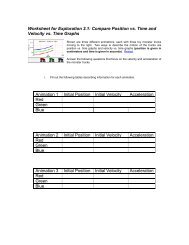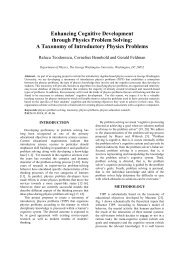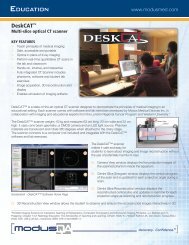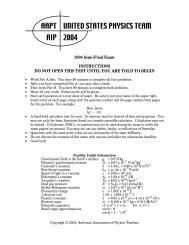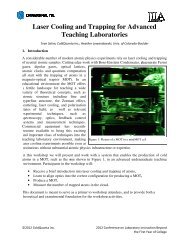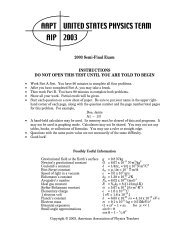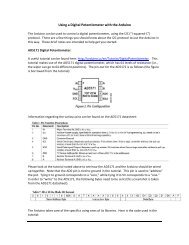Worksheet for Exploration 31.4 - comPADRE
Worksheet for Exploration 31.4 - comPADRE
Worksheet for Exploration 31.4 - comPADRE
Create successful ePaper yourself
Turn your PDF publications into a flip-book with our unique Google optimized e-Paper software.
<strong>Worksheet</strong> <strong>for</strong> <strong>Exploration</strong> <strong>31.4</strong>: Phase Angle and Power<br />
Assume an ideal power supply. The graph shows<br />
the voltage (red) as a function of time across the<br />
source and the current (black) through the circuit<br />
(voltage is given in volts, current is given in<br />
milliamperes, and time is given in seconds).<br />
(Note: the initial current versus time graphs are<br />
not centered about 0 because of the initial state of<br />
the capacitor and inductor.) Restart.<br />
To calculate the power dissipated by an RLC<br />
series circuit you can not simply use I rms V rms because the power supply current and voltage are not in phase<br />
(unlike with a purely resistive load). This is due to the different phase shifts between voltage and current<br />
associated with the capacitors and inductors (the current through all elements must be the same so the<br />
voltages across each are phase shifted from each other, see Illustrations <strong>31.4</strong> and 31.5). Here the<br />
equations <strong>for</strong> calculating power are<br />
P = I rms 2 R = I rms V rms cosφ = I rms 2 Zcosφ,<br />
where Z is the impedance of the series circuit (V rms /I rms )and φ is the phase shift between current and voltage<br />
defined as (ω = 2πƒ)<br />
Z = (R 2 + (ωL - 1/ωC) 2 ) 1/2 and cosφ = R/Z.<br />
a. Pick a frequency value. Find the impedance from V rms /I rms .<br />
Frequency = _______<br />
V rms = ______<br />
I rms = ______<br />
Z = ____________<br />
b. Compare this value with the calculated value found using the equation above.<br />
R = _____<br />
L = _____<br />
C = ______<br />
ω = 2 π f = ______<br />
Z = (R 2 + (ωL - 1/ωC) 2 ) 1/2<br />
= ________
c. Calculate the phase shift.<br />
i. cosφ = R/Z so φ =<br />
d. Compare this calculated value with the value of phase shift measured directly from the graph. To<br />
measure the phase angle, since one period (1/ƒ) represents a phase shift of 2π, measure the time<br />
difference between the peaks of the voltage and current plots and divide by the period (the time<br />
between the peaks of the voltage or the current) to find the percentage of 2π by which the current is<br />
shifted.<br />
T (period) = ____________<br />
t 1 = Time at a maximum of voltage = ________<br />
t 2 = Time at nearest maximum of current = ________<br />
φ = phase shift = 2 π (t 1 -t 2 )/T = _________<br />
e. What is the power dissipated



